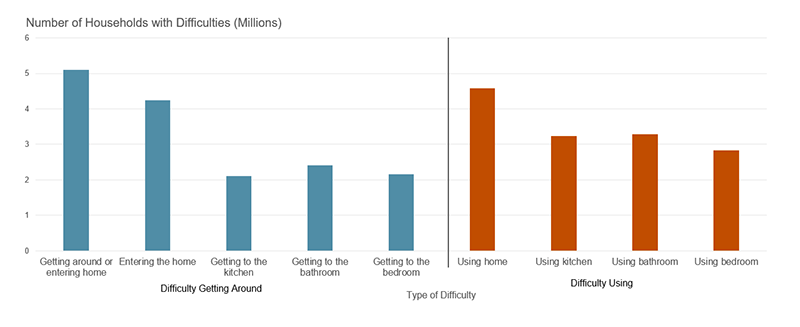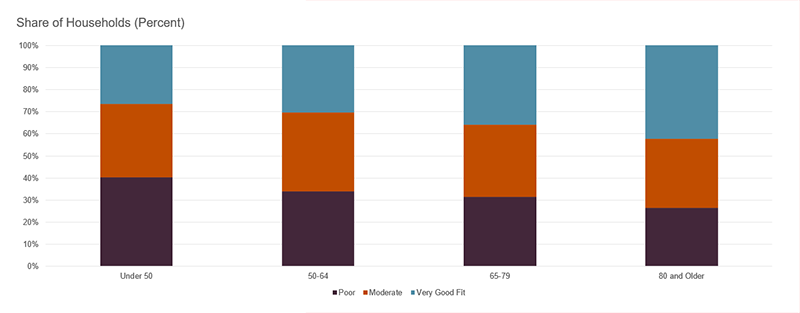Does the House Fit? Residents’ Experiences of Home Accessibility
Health and lifestyles changes associated with advanced age make the home environment increasingly important to wellbeing, independence, and satisfaction. A poor housing fit—a mismatch in between the design of a home and an older resident’s needs—can disrupt an older resident’s routines, increase dependence on others, contribute to housing instability, and lower both life satisfaction and expectancy. In a new paper, “How Well Does the Housing Stock Meet Accessibility Needs? An Analysis of the 2019 American Housing Survey,” Jennifer Molinsky, Whitney Airgood-Obrycki, and I examined data on residents’ experience of their homes to assess the nature of such mismatches.
Using AHS data, we identify the demographic characteristics of residents who are more likely to have difficulty entering, navigating within, and using their homes (Figure 1). This work on housing fit builds on a 2016 Center report in which we used 2011 AHS data to find that less than 4 percent of homes had even basic elements of accessibility, defined as a combination of a no-step entrance or ramp plus a bedroom and bathroom on the entry-level. However, the 2011 survey included very little about the implications of these observed accessibility measures on the daily lives of residents. The new work maps out residents’ experiences entering, navigating around, and using their homes.
We find that difficulty entering the home is the most common challenge, impacting 4.2 million households. Additionally, 3.2 and 3.3 million households have difficulties with the kitchen and bathroom respectively. Taken together, about 5 percent of households, or a total of 6.8 million, have at least one resident who has a hard time getting into, getting around, or using the home.
Figure 1: Households Most Frequently Reported Difficulty with Navigating Their Homes
Notes: Difficulties are reported only for people with a long-term condition. Households with a difficulty have at least one member who reports a long-term condition.
Source: Authors’ tabulations of US Housing and Urban Development, 2019 American Housing Survey.
Not surprisingly, these difficulties increased with age. Half of all households with a resident who found it difficult to navigate their home and more than half who had a hard time using the home were living in a household headed by someone 65 or older. Fully 10 percent of households headed by someone 80 or older had a resident with a difficulty using the kitchen, bathroom, or both. While the shares of navigational difficulties increased with age, the largest number of households reporting difficulties were younger, headed by someone 50-64 and 65-79.
Disabilities and assistive device use were also related to poor housing fit. Households in which a member had difficulty dressing or bathing were more likely to report problems using, entering, or navigating in the home (67 percent) and nearly half of households with a resident who had difficulty running errands experienced poor housing fit. Among older adult-headed households, one-third of households with a resident who used a manual wheelchair, electric wheelchair, a crutch, or other mobility aid also reported difficulty navigating or using the home. This compares with just 2 percent of older adult households without a resident who used a mobility aid.
Housing fit was additionally linked to both income and tenure status. Across age groups, higher income residents had better housing fit. Ten percent of households with incomes below $30,000 reported fit difficulties as compared with just three percent of households with incomes of at least $75,000. Older renters also had poorer housing fit as compared with owners, with almost a quarter of renters over 80 reporting difficulties getting around or using the home as compared with closer to 15 percent of owners in this age group.
There were additional disparities in housing fit by race and ethnicity, with white households generally reporting better housing fit after controlling for age. At older ages, households headed by a Black or Hispanic resident were over 10 percentage points more likely to experience poor housing fit than households headed by similar-aged white residents.
Interestingly, the relationship between housing fit and housing satisfaction was more complex than these many demographic correlations suggest. While older adult-headed households were more likely to report poor housing fit, older householders with a mobility-aid user generally expressed more satisfaction with the extent to which the home’s layout and features met household needs as compared with younger households who also had a mobility-aid user (Figure 2). This provocative finding suggests that observable measures of fit, such as ability to enter or use rooms in the house, may not align precisely with a resident’s feelings about and satisfaction with their home.
Figure 2: Among Households in Which Someone Used a Mobility Device, Older Adults Reported Higher Satisfaction with Their Housing Fit
Notes: Mobility devices include canes, crutches, or wheelchairs. Households who rated their home 1 or 2 on a 5-point scale from “Not at all” to “Very well” were categorized as having poor fit. A rating of 3 or 4 was considered moderate fit, and a rating of 5 was very good fit.
Source: Author tabulations of US Housing and Urban Development, 2019 American Housing Survey.
This analysis finds that millions of households include an adult resident who is unable to access or use critical parts of their home such as the bathroom or kitchen. Poor housing fit reduces functional independence and potentially lowers the quality of life for residents, many of whom are older, Black or Hispanic, disabled, or living with low-income. We need additional research to improve our understanding of the specific housing features that are most implicated in poor housing fit, particularly in light of the provocative finding that residents’ feelings of satisfaction with their homes do not align precisely with the observed measures of their ability to use their homes and given the rapidly increasing population of older adults. Resources will be needed to modify homes and make them more accessible so that residents can enter, navigate, and use key features of their home, and to promote options for healthier, more functional aging in the home of their choice.



